check engine AUDI A8 2011 Owner's Manual
[x] Cancel search | Manufacturer: AUDI, Model Year: 2011, Model line: A8, Model: AUDI A8 2011Pages: 302, PDF Size: 76.07 MB
Page 226 of 302
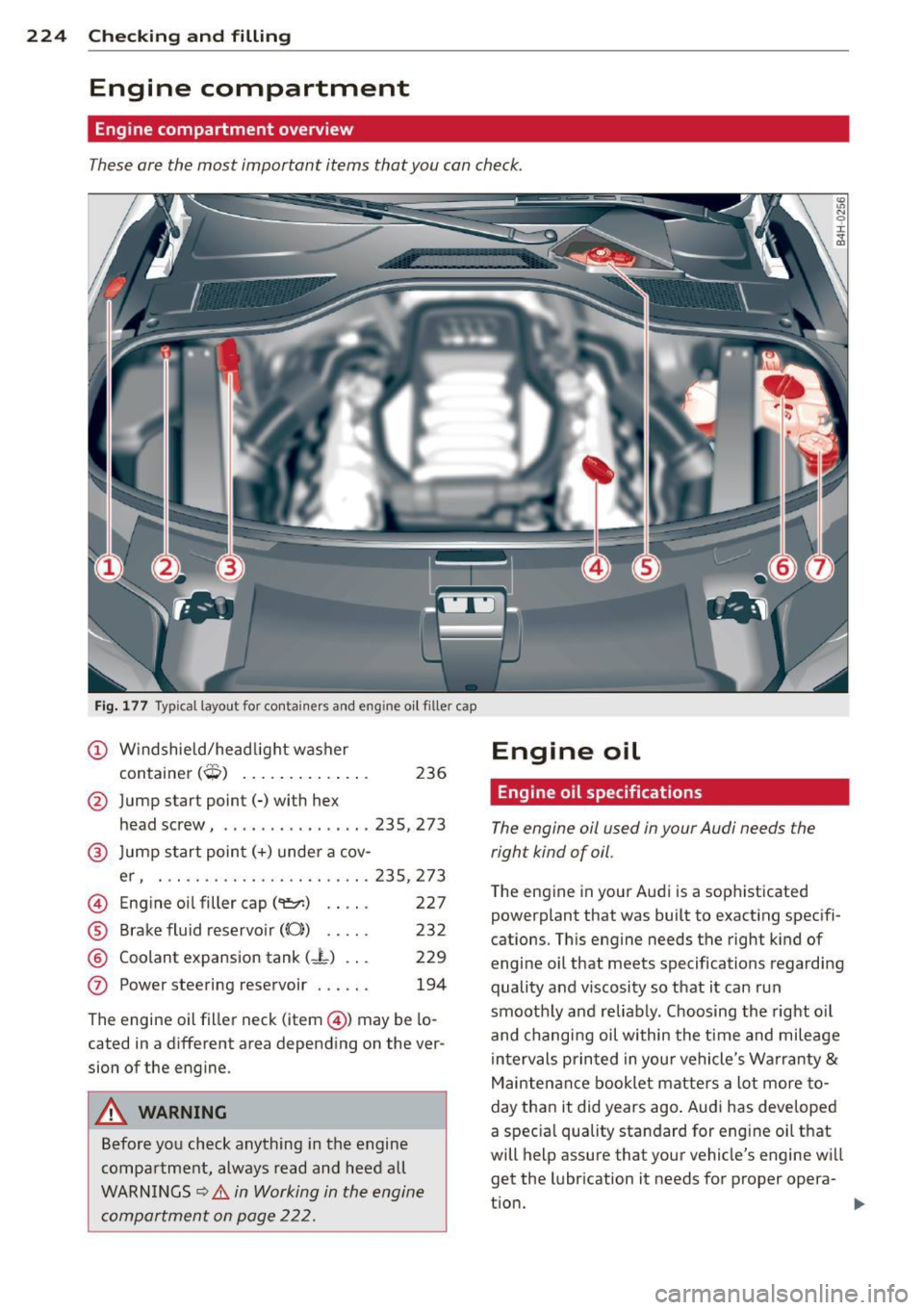
224 Checking and filling
Engine compartment
Engine compartment overview
These are the most important items that you can check.
Fig . 177 Typ ical layout for conta iners a nd eng ine o il filler cap
(D W indshield/head light washer
t . (?::..) con
amer ~ .... ... . ... .. . 236
@ Jump start point(-) with hex
h ead screw, ................
235, 273
@ Jump start point(+) unde r a cov-
e r, . ...... .... ......... .. .
23 5, 273
© Eng ine oi l filler cap ('t::r.) . . . . . 227
® B rak e fluid reservo ir ((0)) . . . . . 232
® Coolant expansion tank (J-) . . . 229
0 Power steering reservoir . . . . . . 194
The engine oil filler neck (item@) may be lo
cated in a d ifferent area depending on the ver
sion of the engine .
A WARNING
Before you check anything in the engine
compartment, always read and heed all
WAR NINGS¢
A in Working in the engine
compartment on page 222.
Engine oil
Engine oil specifications
The engine oil used in your Audi needs the
right kind of oil.
T he eng ine in your Audi is a sophisticated
powerplant that was built to exacting specifi
cations . Th is engine needs the right k ind of
engine oil that meets specifications regarding
quality and v iscosity so that it can run
smoothly and reliab ly . Choosing th e right o il
and changi ng oil within the t ime and mileage
in tervals prin ted in you r vehicle's Warr anty
&
Maintenan ce booklet matte rs a lot more to
day tha n it did years ago . Audi has develope d
a spec ia l quality standard for engine oil that
will help assure that you r vehicle's engine w ill
get the lubr ication it needs for proper opera-
t ion. ..,.
Page 227 of 302
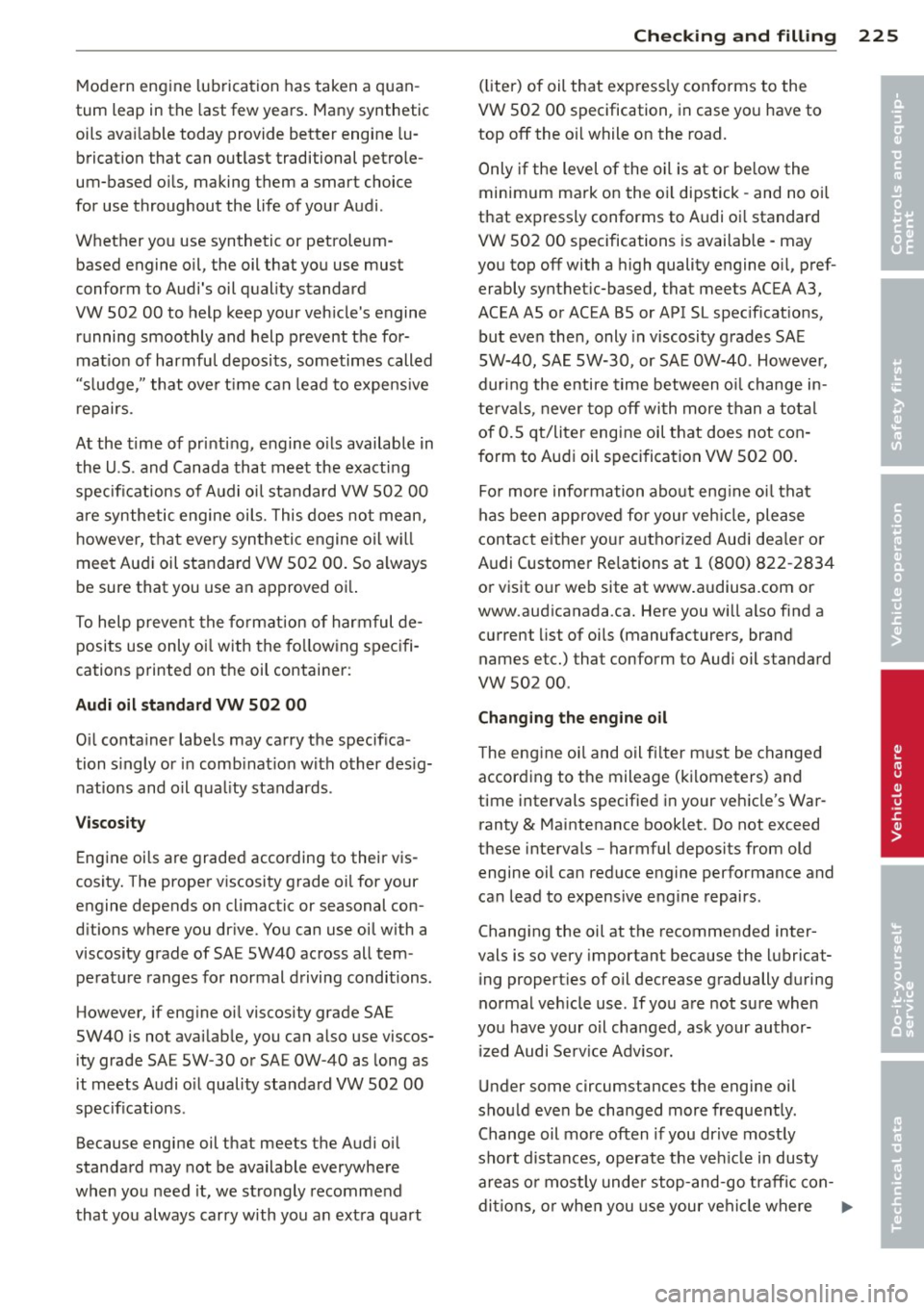
Modern eng ine lubrication has taken a quan
tum leap in the last few years . Many synt hetic
oils ava ilable today provide better engine lu
brication that can outlast traditional petrole
um-based o ils, making them a smart choice
for use throughout the life of your Audi .
Whether you use synthetic or petroleum based engine oil, the oil that you use must
conform to Audi's oil quality standard
VW 502 00 to help keep your veh icle's engine
running smoothly and help prevent the for
mat ion of harmfu l deposits, sometimes called
"s ludge," that ove r time can lead to expensive
r epairs .
At the t ime of pri nting, engine o ils available in
the U .S . and Canada that meet the exacting
specifications of Audi oi l standard VW 502 00
are synthetic engine oils. This does no t mean,
however, that every syn thetic engine oi l w ill
meet Audi oil standard VW 502 00. So a lways
be sure that you use an approved oi l.
To help preve nt the format ion of harmful de
posits use only oi l with the fo llow ing spec ifi
cations printed on the oil container:
Audi oil standard VW 502 00
O il conta iner labels may carry the specif ica
tion s ingly o r in comb inat ion w ith other des ig
nations and oil qua lity standards .
Viscosity
Engine oi ls are graded according to their vis
cosity. The proper v iscosity grade oi l for your
engine depends on cl imactic or seasonal con
d itions where you dr ive. You can use oil with a
viscosity grade of SAE SW40 across all tem
pe rature ranges for normal d riving conditions .
However, if eng ine oi l viscosity grade SAE
SW40 is not avai lab le, you can also use viscos
ity grade SAE SW -30 or SAE OW-40 as long as
it meets Audi o il quality standard VW 502 00
specifications.
Because engine oil that meets the A udi oil
standard may not be available everywhere
when you need it, we s trongly recomme nd
that you always carry with you a n ext ra quart
Checkin g and fillin g 225
(li ter) of oil that exp ress ly con forms to the
VW S02 00 specification , in case you have to
top
off the o il while on the road.
Only if the level of the o il is at or be low the
minimum mark on the o il dipstick -and no oi l
that expressly conforms to Audi oi l standard
VW S02 00 specifications is availab le - may
you top
off with a high quality engine o il, pref
erably synthet ic-based, that meets ACEA A3,
ACEA AS or ACEA BS or API SL spec ificat ions,
but eve n then, only in v iscosity g rades SA E
SW- 40, SA E 5W-30, or SAE OW-40 . Howeve r,
dur ing the entire time between o il change in
te rv al s, never top
off wi th more than a to ta l
of 0. 5 qt/liter eng ine oil that does not con
form to Audi oil specification VW 502 00 .
Fo r more informa tion abo ut eng ine oi l tha t
h as been approved for your veh icle, please
contac t either yo ur autho rized Aud i dea le r or
Audi C ustome r Re lations at 1 (800) 822 -2834
or visit o ur web site at www .a udiusa.com or
www.aud icanada .ca. Here you w ill also find a
current list of oils (manufacturers, brand
names etc.) that conform to Audi oil standard
vw 502 00.
Changing the engine oil
T he eng ine oi l and oil f ilter m ust be changed
according to the mileage (ki lome ters) and
time intervals specified i n your vehicle's War
ranty
& Maintenance booklet. Do not exceed
these interva ls - harmful deposits from old
engine oil can reduce engine performance and
can lead to expensive engine repairs.
Changi ng the oil at the recommended inter
vals is so very important beca use the l ubricat
ing propert ies of oil decrease gradually during
norma l veh icle use . If you a re not sure when
yo u have your o il cha nged, ask your author
ized Audi Se rv ice Adv isor.
Under some circumstances the engine oil
shou ld eve n be changed more frequent ly.
Change oil mo re often if you dr ive most ly
sho rt distances, operat e the ve hicle in dusty
areas o r most ly under stop-and -go traff ic con-
d iti ons, o r when you use your vehi cle where .,..
•
•
Page 228 of 302
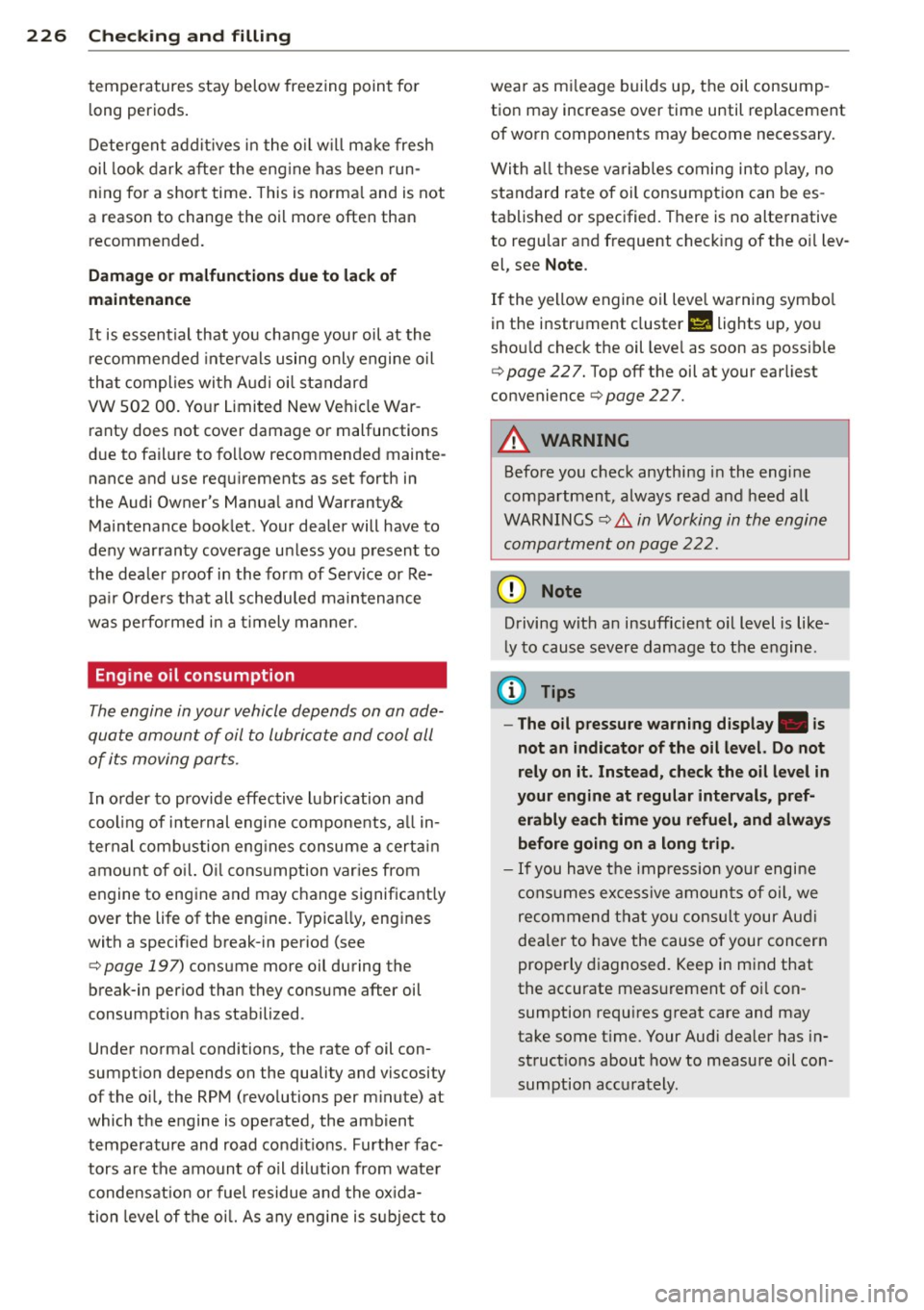
226 Check ing and filling
temperatures stay below freezing point for
long periods.
Detergent add it ives in the o il w il l make fresh
oil look dark after the eng ine has been run
ning for a short time . This is norma l and is not
a reason to change the oi l more often than
recommended.
Dam age or ma lf u ncti ons du e to lack of
m ainten ance
It
is essential that you change your oil at the
recommended in tervals using only engine o il
that complies with Audi oi l standard
VW 502 00. You r Limited New Vehicle War
ranty does not cover damage or malfunctions
due to fail ure to fo llow recommended mainte
nance and use requ irements as set forth in
the Audi Owner's Manual and Warranty&
Maintenance book let . Your dealer will have to
deny warranty coverage unless you present to
the dea ler proof in the form of Service or Re
pa ir Orders that all scheduled maintenance
was performed in a t imely manner.
Eng ine oil consumption
The engine in your vehicle depends on an ade
quate amount of oil to lubricate and cool all
of its moving parts.
In order to provide effective lubrication and
cool ing of internal engine components, a ll in
ternal comb ustion eng ines consume a certa in
amount of oil. O il consumption varies from
engine to engine and may change significantly
over the life of the engine. Typica lly, engines
with a specif ied break-in period (see
¢
page 197) consume more oil during the
break-in period than they consume after oil
consumption has stabilized.
Under norma l conditions, the rate of oil con
sumpt ion depends on the quality and viscosity
of the oil, the RPM (revolutions per m inute) at
which the engine is operated, the ambient
temperature and road condit ions . Further fac
tors are the amount of oil d ilution from water
condensat ion or fuel residue and the ox ida
tion level of the oi l. As any engine is subject to wear as mi
leage builds up, the oil consump
tion may increase over time until replacement
of worn components may become necessary.
With a ll these variab les coming into play, no
standard rate of oil consumption can be es
tablished or specified. There is no alternative
to regu lar and frequent check ing of the o il lev
el, see
Note .
If
the yellow engine oil leve l warning symbo l
in the instrument cluster
m lights up, yo u
shou ld check the oil leve l as soon as possib le
¢
page 22 7. Top off the oil at your earliest
convenience ¢
page 22 7.
A WARNING '"---
Before you check anything in the engine
compartment, always read and heed all
WARNINGS¢
A in Working in the engine
comportment on page 222.
(D Note
Driving w ith an insufficient o il level is like
ly to cause severe damage to the engine .
(D Tips
-The oil pressu re warn ing display. is
not an indicator of the oil le vel. Do not
r el y on it . In ste ad, ch eck the oil lev el in
y our engin e at regular inter vals , pref
erably ea ch time you r efu el, and alway s
before going on a long trip .
-If you have t he impression yo ur engine
cons umes ex cessive amoun ts of o il, we
recommend that you consu lt your Aud i
dea ler to have the cause of your concern
properly diagnosed. Keep in mind that
the accurate meas urement of oi l con
sumption requ ires great care and may
take some t ime. Your Audi dea ler has in
structions about how to measure oil con
sumption accurately.
-
Page 229 of 302

Checking the engine oil level
Fig . 178 D is p lay: o il level indica tor
Park your vehicle on a level surface.
• Shut the engine off when i t is wa rm.
• Swi tch on ly the ignition back on .
• Wait approximately two minutes .
• Se lect :
I CAR I funct ion button > C ar sys tem s
cont rol button > Se rvicing & c heck s > Oil
le ve l.
• Check the oil level in the display¢ fig. 178 .
Add engine oil if the bar of the oil level indi
cator is near "min " ¢
page 22 7.
Depending on the way the veh icle is driven
and the operating conditions, oil consumpt ion
can be up to 1/2 quart per 600 m iles (0 .S liter
per 1 ,000 km) . Consumption may be h igher
within the first 3,000 miles (S,000 km) .
@ Tips
The oil level indicator in the MMI Display is
only an informat ion d isp lay . If the oil leve l
is low, a minimum o il warning appears in
t he ins trumen t cluste r. Add oi l
¢
page 22 7 . If the hood h as been opened,
the current oil level is shown in the instru
ment cluster the next time the ignition is
sw itched on.
Checkin g and fillin g 22 7
Adding engine oil 'i=:1:
Fig. 179 Eng in e compa rtm en t: co ve r on the engine oi l
filler n eck
Before you check anything in the eng ine com
partment ,
alw ays re ad and he ed all WARN
INGS
c:> &, in Working in the engine compart
ment on page 222 .
• Unscrew the cap~ to the eng .i ne o il filling
hole
c:> fig . 179.
• Carefully top off with the appropriate oil in
0.S liter doses .
• Check the oil level again after two minutes
¢ page 22 7.
• Top off the oil aga in, if necessary .
• Screw the cap back on the filling hole .
A WARNING
-Wh ile topping off, the oil must not come
in contact w ith hot engine parts -fi re
hazard!
- The oi l filler cap must be p roperly se
cured to prevent oil from being sprayed
on the hot engine and exhaust system
when the engine is runni ng -fire ha zard!
- I f your s kin has come in contact with the
engine o il, you must subse quently
cleanse it thoroughly.
(D Note
- Check the oil level using the MMI. If the
message
Please reduce oil level appe ars,
c ontact yo ur a uth ori zed Aud i dea ler o r
ot her qualified workshop to have excess
oil extracted if necessary.
- Audi d oes not re commend the u se of oil
additi ves. The y m ay dama ge the engine
1111-
Page 230 of 302
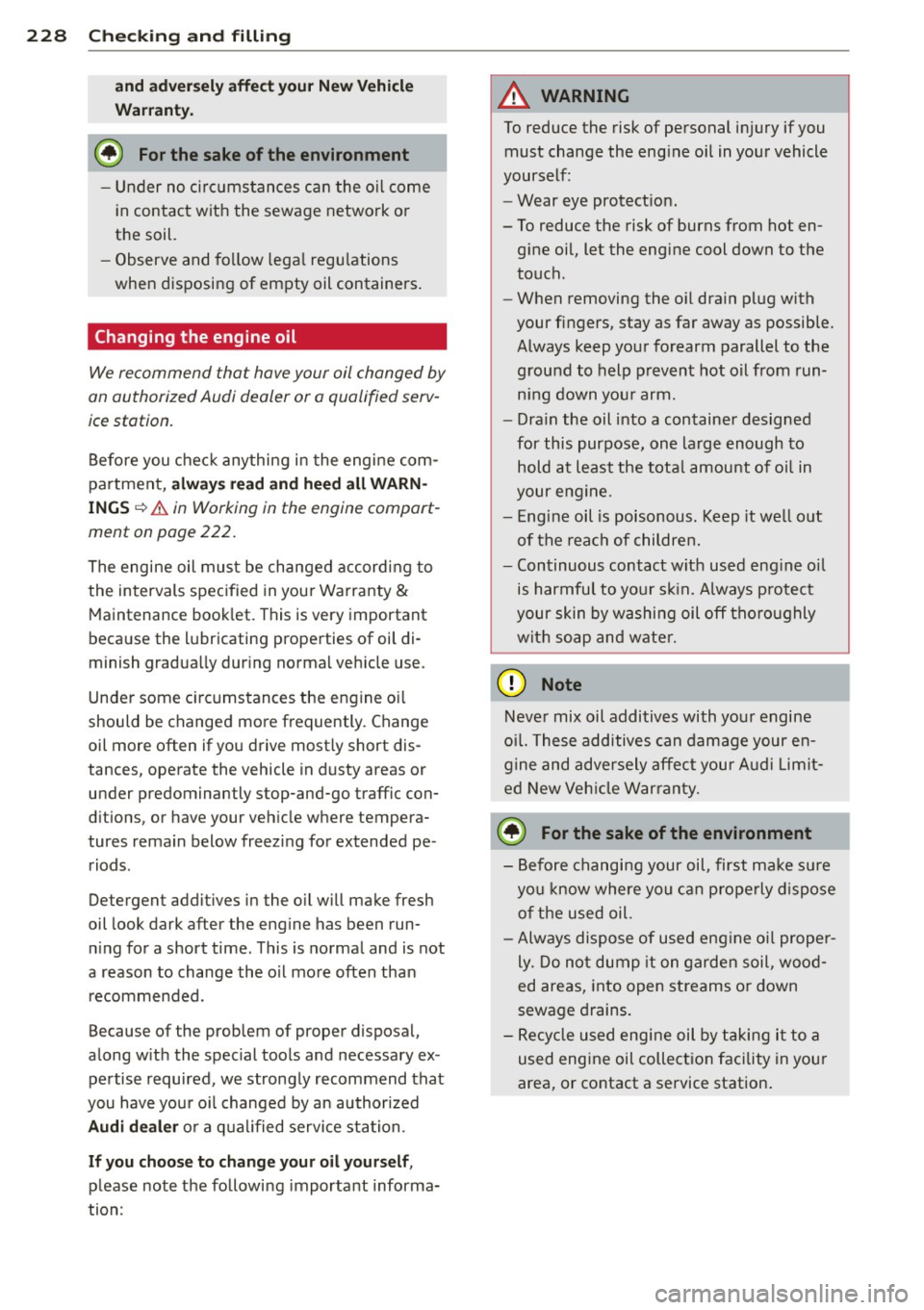
228 Check ing and filling
and ad versely a ffect yo ur New Vehicl e
W arrant y.
@) For the sake of the environment
- Under no circums tances can the oil come
in contact with the sewage network o r
the soil.
- Observe and follow lega l regu lations
when disposing of empty oil containers .
Changing the engine oil
We recommend that have your oil changed by
an authorized Audi dealer or a qualified serv
ice station.
Before you check anything in the engine com
partment,
a lw ays rea d an d h eed all WARN
INGS c::> .& in Working in the engine compart
ment on page 222.
The engine oil must be changed accord ing to
the intervals specified in your Warranty
&
Maintenance book let. This is very important
because the lubricating properties of oil di
minish gradua lly during normal vehicle use .
Under some ci rcumstances the engine oi l
should be changed more frequently. Change
oil more often if you drive most ly short dis
tances, operate the vehicle in dusty areas or under predominantly stop-and-go traffic con
ditions, or have your vehicle where tempera
tures remain below freezing for extended pe
riods .
Detergent addit ives in the oil w ill make fresh
oil look dark after the eng ine has been run
n ing for a short time. This is normal and is not
a reason to change the oil more often than recommended.
Because of the problem of proper disposal,
along w ith the special tools and necessary ex
pertise required , we strongly recommend that
you have your o il changed by an authori zed
A udi de ale r or a q ual ified servi ce station.
If you choo se to c hang e y our oi l your self,
please note the followi ng important informa
tion :
A WARNING
To reduce the risk of personal injury if you
must change the eng ine oil in your vehicle
yourself:
- Wear eye protect ion.
- To reduce the risk of burns from hot en- gine oil, let the engine cool down to the
touch.
- When removing the o il dra in plug with
your fingers, stay as far away as possible.
Always keep your forearm parallel to the
ground to help p revent hot oil from run
n ing down you r arm.
- Dra in the oil into a container designed
for this purpose, one large enough to
hold at least the total amount of oil in
your engine.
- Engine oil is poisonous. Keep it we ll out
of the rea ch of childre n.
- Continuous contact with used eng ine o il
is harmful to your sk in. Always protect
your skin by washing oil off tho roughly
with soap and wate r.
@ Note
Never mix oil additives with your engine
oi l. These additives can damage your en
g ine and adversely affect you r A ud i Limit
ed New Veh icle War ranty.
@ For the sake of the environment
- Before changing your oil, first make su re
you know where you can prope rly dispose
o f the used oil.
- Always dispose of used eng ine oi l proper
ly. Do not dump it on garden soil, wood
ed areas, into open streams or down
sewage drains.
- Recycle used engi ne oil by taking it to a
used engine oil collection facility in you r
area, or contact a service station.
Page 231 of 302
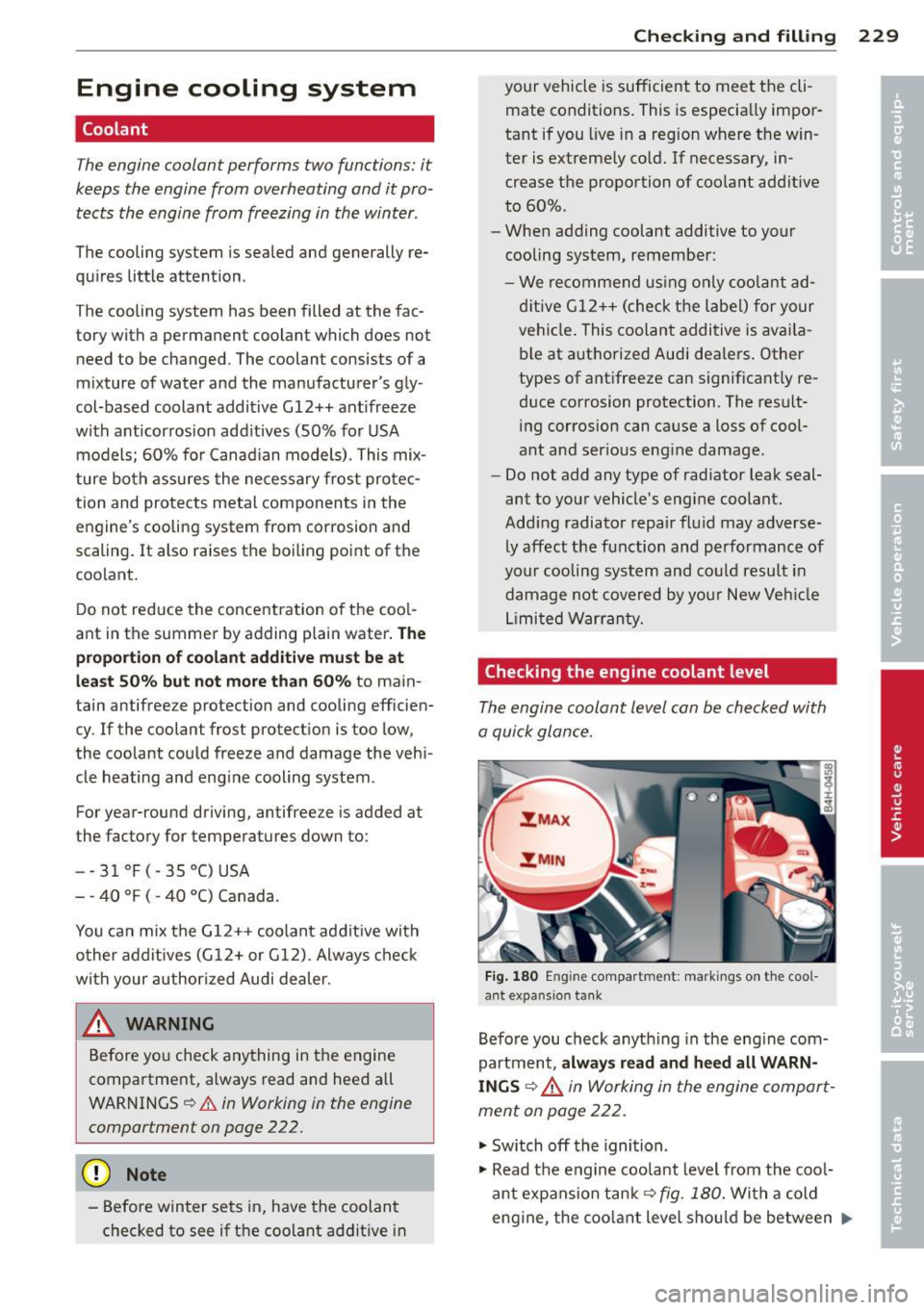
Engine cooling system
Coolant
The engine coolant performs two functions: it
keeps the engine from overheating and it pro
te cts the engine from freezing in the winter .
The cooling system is sealed and generally re
qu ires little attention .
The cooling system has been filled at the fac
tory with a permanent coolant which does not need to be changed. The coolant consists of a
mixture of water and the manufacturer's gly
col-based coolan t additive G12++ ant ifreeze
with a nticorrosion add itives (50% fo r USA
models; 60% for Canad ian models). This mix
ture bot h assu res the ne ces sary frost protec
tion and protects metal components in the
engine's cooling system from corrosion and
scaling. It also raises the bo ili ng po int of t he
coolant.
D o not red uce the concentration of the coo l
ant in the summe r by adding plain water .
The
proportion of coolant addit ive must be at
least 50% but not mo re than 60 %
to main
tain antifree ze protection and cooling efficien
cy. If the coolant frost protect ion is too low,
the coolant could freeze and damage the veh i
cle heating and eng ine cooling system .
For year-round driving, antifree ze is added at
the factory for temperatures down to:
- -3 1°F (-35°C)USA
- -4 0 ° F ( - 4 0 °C) Canada.
You can mix t he G12 ++ cool ant ad ditive with
o ther addit ives (G1 2+ or G1 2). Alway s check
w ith your author ized Audi dealer.
& WARNING
Before yo u check any thing in the engine
compartment, always read and hee d all
W AR NIN GS
Q .&. in Working in the engine
compartment on page 222.
(D Note
- Before win ter se ts in , have the coolan t
checked to see if the coolant addit ive i n
Checkin g and fillin g 229
your vehicle is sufficient to meet the cli
mate conditions . This is especia lly impor
tant if you live in a reg ion where t he win
ter is extreme ly co ld. If necessary, in
crease t he p ropo rtion of coo lant add itive
t o 60% .
- Whe n add ing coolant additive to your
cooling system , remember :
- W e re co mme nd usin g only cool ant ad
dit ive G 12++ (check t he labe l) for your
vehi cle. This coolan t addi tive is ava ila
b le at a uthorized Audi dea le rs . Othe r
types of ant ifreeze can significant ly re
d uce co rrosi on protection. The res ult
i n g corrosion can ca use a loss of co ol
ant and ser io us eng ine damage .
- Do not add any type of rad iator leak seal
ant to you r vehicle's eng ine c oolant .
Add ing radiator repair fl uid may adverse
ly affect t he f unction and performance of
yo ur cooling sys tem and co uld resu lt i n
damage not covered by yo ur New Ve hicle
Li mi ted Warran ty.
Checking the engine coolant level
The engine coolant level can be chec ked with
a quick glan ce.
:!, MAX
% MIN
Fig. 180 En gin e compar tment: mark ings on t he coo l
a n t expa nsion tank
Befo re you check a nyth ing in the eng ine com
partment,
always read and heed all WARN
INGS ¢.&, in Working in the engine compart
men t on page
222 .
"' Switch off the ignition .
"' Read the engine coo lant level from the coo l
ant expa nsion tank
Qfig . 180. Wit h a co ld
eng ine , the coo lant level s hou ld be between
1JJ>-
Page 232 of 302

230 Check ing and filling
th e "min" and "max" markings. When the
engine is wa rm, the level may be slightly
above the "max" marking.
The location of the coolant expansion tank
can be seen in the engine compartment ill us
tration ¢
page 224 .
To obtain an accurate read ing , the engine
must be switched
off .
The expans io n tank in you r vehicle is equipped
with an e lectric coolant level se nsor.
When the coolant level is too low, the warning light in the A uto-Check System ¢
page 15 will
i llum inate u nti l you add coolant and the level
has been restored to normal. Even though
there is an electric coolant level sensor , we
still recommend you check the coolant leve l
from time to time.
Coolant loss
Coolant loss may indicate a leak in the cooling
system. In the event of coolan t loss, the cool
ing system should be inspected immedia tely
by your authorized Audi dealer. It is not
enough mere ly to add coolant.
I n a
se aled system, losses can occur only if
the boiling point of the coolant is exceeded as
a result of overheat ing.
A WARNING
T he cooling system is unde r pressure and
can get ve ry hot . Reduce the risk of sca ld
ing from hot coolant by following these
steps.
- Turn off the engine and allow it to cool
down.
- Protect yo ur face, hands and arms from
escaping fluid and steam by cove ring the
cap with a large, thick rag.
- Turn the cap slowly and very carefu lly in
a counter-clockwise direction wh ile ap
plying light, downward pressure on the
top of the cap .
- To avoid being b urned, do not spill ant i
freeze or coolant on the exhaust system or hot eng ine parts . Under ce rtai n condi -
'
tions, the ethylene glycol in engine coo l
ant can catch fire.
@ Note
Do not add any type o f radiato r leak sea l
ant to your vehicle's engine coolant. Add
i ng radiator repa ir fluid may adverse ly af
fect the funct ion and performance of your
cooling system and could result in damage not covered by your New Veh icle L imited
Warranty .
Adding coolant
Be very careful when adding engine coolant.
Before you check anyth ing in the engine com
partment,
always read and heed all WARN
INGS
c> .&. in Working in the engine compart
ment on page
222 .
• Turnoff the engine .
• Let the eng ine cool down.
• Place a thick rag over the coolant expansion
tank
c> page 22 9, fig . 180 and carefully
tw ist t he cap co unter-clockwise c> ,& .
• Add coo lant .
• Twist the cap o n again
tightly.
Replacement engine coo lant must conform to
exact spec ificat ions ¢
page 229, Coolant .
Even in a n emerge ncy, if coo la nt addi-
t ive G 12++ , G12+ or G12 is not ava ilable , do
not use a d iffe ren t addit ive. Use plain water
instead unt il you can get the cor rect add itive
and can restore the correct ratio . This sho uld
be don e as soon as possible.
If you have los t a consider able amount o f
coolant, then you sho uld add cold ant ifreeze
and cold wate r on ly when the engine is cold.
Always use
new engine coo lant when refilling.
Do not f ill coolant above the "MAX" mark. Ex
cess coola nt w ill be fo rced o ut through the
pressure relief valve in t he cap when the e n-
gine becomes ho t.
Ill>
Page 233 of 302

A WARNING
-=
-The cooling system is under pressure and
can get very hot . Reduce the risk of
scald ing from hot coolant by following
these steps .
- Turn
off the engine and a llow it to cool
down.
- Protect your face, hands and arms from
escaping fluid and steam by covering
the cap with a large, thick rag.
- Turn the cap slowly and very carefully in a counter-clockwise direction while
applying light, downward pressure on
the top of the cap.
- To avoid being burned, do not spi ll an
tifreeze or coolant on the exhaust sys
tem or hot engine parts. Under certa in
conditions, the ethylene glycol in en
g ine coolant can catch fire.
- Antifreeze is poisonous. Always store an
t ifreeze in its original container and well
out of the reach of children.
- If you drain the coolant, it must be
caught and safely stored in a proper con
tainer clearly marked "poison".
(D Note
- Coolant pollutes the env ironment and
could cause an engine fire. Excess cool
ant w ill be forced out through the pres
sure relief valve in the cap when the en
gine becomes hot.
- If, in an emergency, only water can be
added, the correct ratio between water
and antifreeze
Q page 229 must be re
stored as soon as possible.
@ For the sake of the environment
Drained coolant should not be reused. Al
ways dispose of used coolant while obse rv
ing all environmental regulations.
Checkin g and fillin g
Radiator fan
The radiator fan switches on automatically by
itself .
The rad iator fan is dr iven by the engine via the
V-belt. The viscous clutch regulates the speed
of the fan according to the temperature of the
coolant .
An auxiliary electric radiator fan* switches on
and
off depending on coolant temperature
and other vehicle operat ing cond it ions .
After you switch the engine
off, the aux iliary
fan can continue running for up to 10 minutes - even with the ignition
off. It can even switch
on again later by itself
Q &., if
- the temperature of the engine coo lant rises
due to the heat build-up from the engine in
the engine compartment, or
- the engine compartment heats up because the vehicle is parked in intense sunlight.
A WARNING
- To reduce the risk of personal in jury nev
er touch the radiator fan .
- The auxiliary electric fan is temperature
controlled and can switch on suddenly
even when the engine is not running.
- The auxiliary radiator fan sw itches on au
tomatically when the engine coolant reaches a certa in temperature and w ill
continue to ru n until the coolant temper
ature drops.
231
•
•
Page 234 of 302
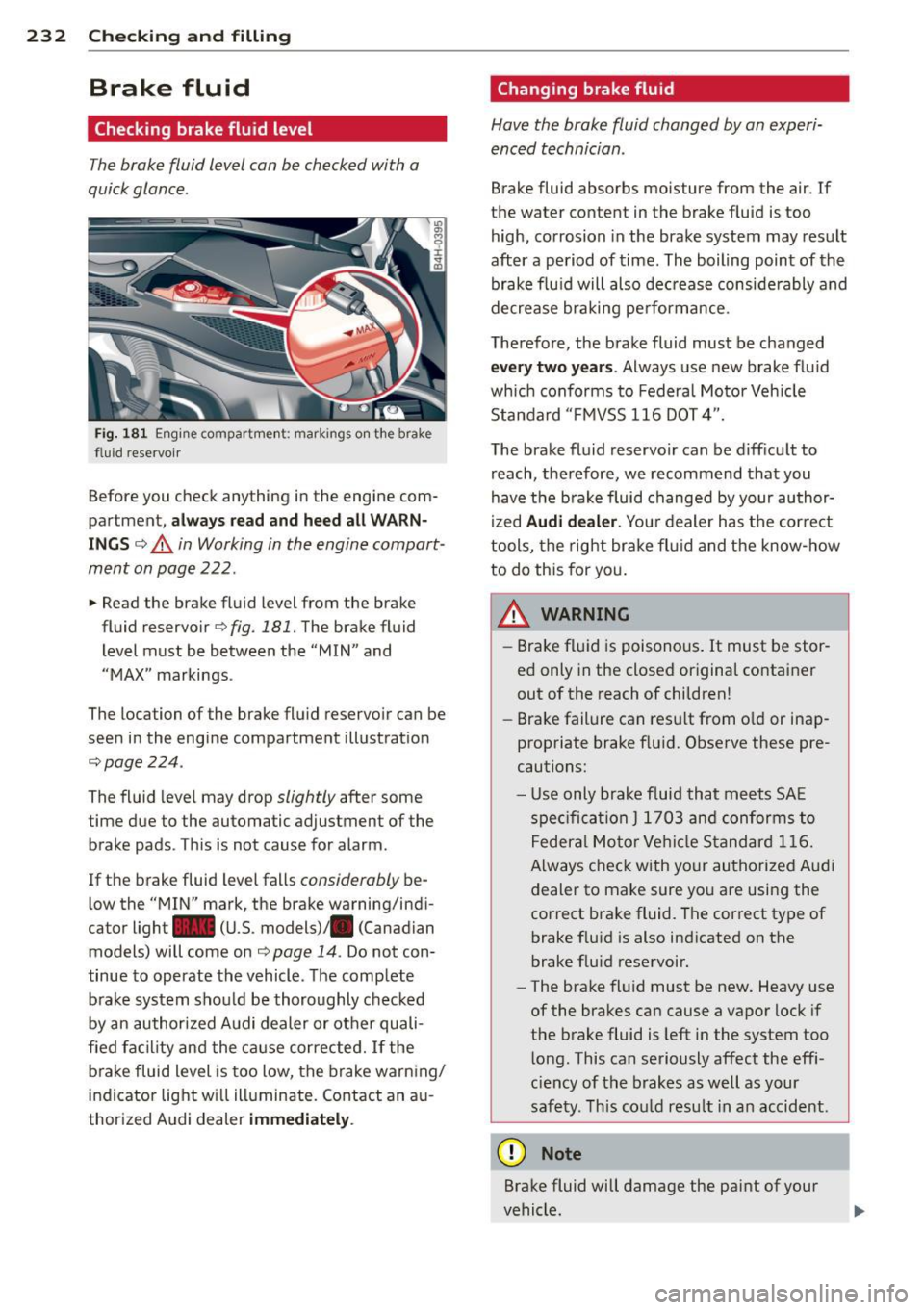
232 Checking and filling
Brake fluid
Checking brake fluid level
The brake fluid level can be checked with a
quick glance .
Fig. 181 Engine compartme nt: markings on the brake
flu id reservoir
Before you check anything in the engine com
partment,
always read and heed all WARN
INGS ¢ .&._ in Working in the engine compart
ment on page 222.
.. Read the brake fluid level from the brake
fluid reservoir ¢
fig. 181. The brake fluid
level must be between the "MIN" and
" MAX " markings .
The location of the brake fluid reservoir can be
seen in the engine compartment illustration
c:::,page224 .
The fluid level may drop slightly after some
time due to the automatic adjustment of the
brake pads . T hi s is not cause for alarm.
If the brake fluid level falls
considerably be
low the "MIN" mark, the brake warning/indi
cator light. (U.S. models)/ . (Canadian
models) will come on ¢
page 14. Do not con
tinue to operate the vehicle . The complete
brake system should be thoroughly checked
by an authorized Audi dealer or other quali
fied facility and the cause corrected.
If the
brake fluid level is too low, the brake warning/
indicator light will illuminate. Contact an au
thorized Audi dealer
immediately .
Changing brake fluid
Have the brake fluid changed by an experi
enced technician .
Brake fluid absorbs moisture from the air. If
t he water content in the brake fluid is too
high, corrosion in the brake system may result
after a period of time . The boiling point of the
brake fluid will also decrease considerably and
decrease braking performance.
Therefore, the brake fluid must be changed
every two years . Always use new brake fluid
which conforms to Federal Motor Vehicle
Standard "FMVSS 116 DOT 4".
The brake fluid reservoir can be difficult to reach, therefore, we recommend that you
have the brake fluid changed by your author
ized
Audi dealer. Your dealer has the correct
tools, the right brake fluid and the know-how
to do this for you .
A WARNING
-Brake fluid is poisonous. It must be stor
ed only in the closed original container
out of the reach of children!
- Brake failure can result from old or inap
propriate brake fluid. Observe these pre
cautions:
- Use only brake fluid that meets SAE
specification
J 1703 and conforms to
Federal Motor Vehicle Standard 116.
Always check with your authorized Audi
dealer to make sure you are using the
correct brake fluid. The correct type of brake fluid is also indicated on the
brake fluid reservoir.
- The brake fluid must be new. Heavy use
of the brakes can cause a vapor lock if
the brake fluid is left in the system too
long . This can seriously affect the effi
ciency of the brakes as well as your
safety. This could result in an accident.
(D Note
Brake fluid will damage the paint of your
vehicle.
Page 236 of 302

234 Check ing and filling
Th e following WARNINGS are very
impo rtant when w ork ing on the b att ery :
Alwa ys hee d the fo llo w ing WARNING SYM
BOLS and safety precaution s when working
o n the battery .
®
@
®
Always w ear eye prot ection.
Batter y acid cont ain s sulfu ric acid.
Alwa ys wear glo ves and e ye p rote c
tion.
No
• sparks
-flames
- smoking.
When a batt ery is charged, it produ
ces hydrog en ga s whi ch i s e xplo sive
a nd could cau se p ers on al injury .
Always keep the battery well out of reach of children .
.8, WARNING
Whenever working on the battery or on
the electrical system, there is the r is k of
inju ry, acc ident and even fire. Read and
heed the following WARNINGS:
- Always wea r eye protection. Do not let
battery acid or any lead particles get on
yo ur skin or clothing. Shield your eyes.
Explosive gases can cause blindness or
other injury .
- Battery acid contains sulfuric acid. Sulfu
ric acid can cause blindness and severe
burns.
- Always wear gloves and eye p rotection .
Do not tilt the battery because ac id
could lea k out of the vent ilation open
ings.
- I f you get battery acid in your eyes or
on your sk in , immediately rinse with
cold water for severa l m inutes and get
medical attention.
- If you should ingest any battery acid ,
seek medical attention immediately .
- Do not expose the battery to an open
flame, electric sparks or an open light .
- Do not smoke. -
Do not interchange the positive and neg
ative cables.
- When working on the battery, be s ure
not to short-circu it the terminals with
too ls or other metal objects. This would
cause the battery to heat up very quickly,
which could lead to damage or explosion and pe rsonal injury.
- When a battery is charged, it produces
hydrogen gas which is explosive and
could cause personal in jury.
-Always keep the battery well out of the reach of children .
- Before work is done on the electrical sys
tem, disconnect the negat ive ground ca
b le .
- Before performing any work on the e lec
tr ical system, switch off the engine and
ignit ion as well as any electrical equip
ment. The negative cable on the battery
m ust be disconnected.
If yo u are just go
ing to replace a light bulb, then it is
enough to switch off the lights .
- Before disconnec ting the bat tery, switch
off the anti -theft alarm system! Other
wise you wi ll set off the alarm.
- When disconnecting the battery, f irst
disconnect the negative cab le and then
the positive cab le .
- Before reconnecting the batte ry, ma ke
sure all e lectr ica l consumers are sw itch
ed off . Reconnect the positive cable first
and then the negative cable . Never inter
change the cables - this could start a fire!
- Never charge a frozen or a thawed-out
battery . It could exp lode! If a battery has
frozen, then it must be replaced. A dis
charged batte ry can freeze over at 32 °F
(0 °() .
-Make sure the vent hose is always attach
ed to the opening on the s ide of the bat
tery .
- Never use batteries which are damaged.
There is the danger of an explosion! Al ways rep lace a damaged battery .